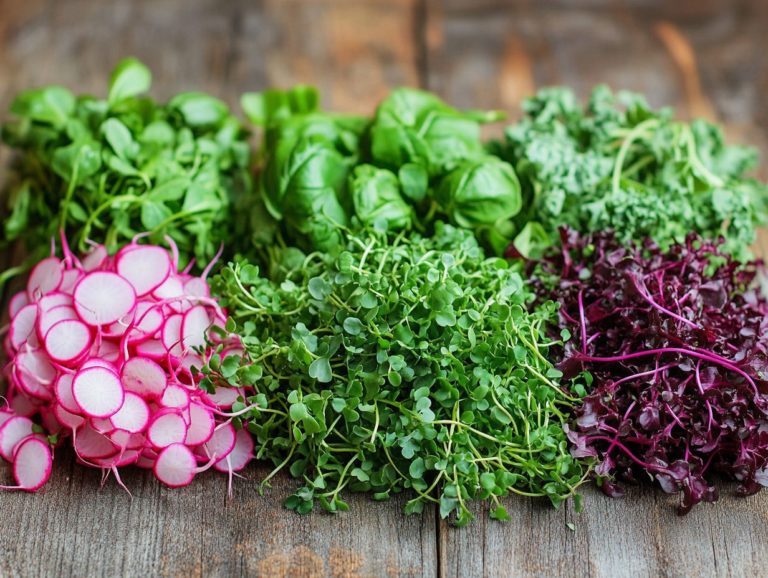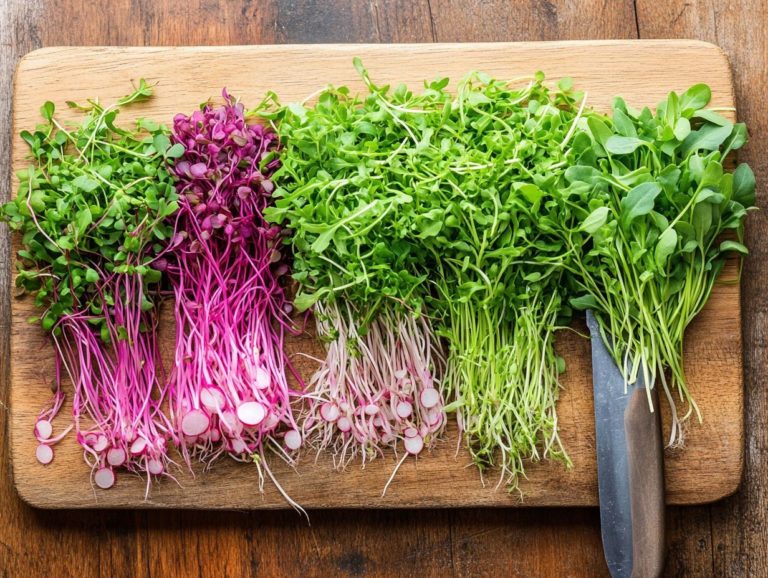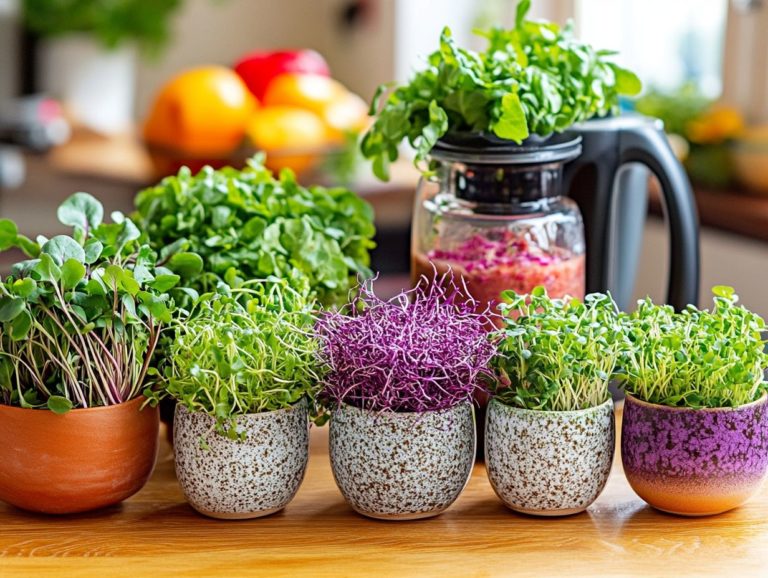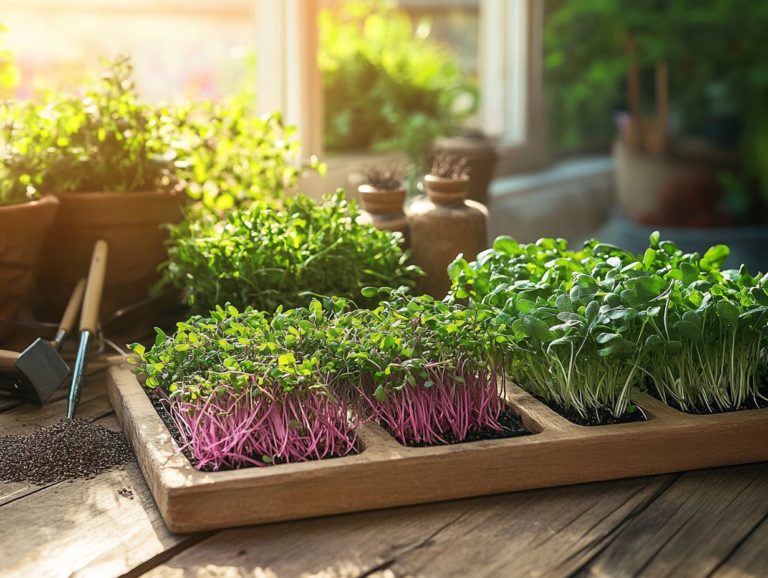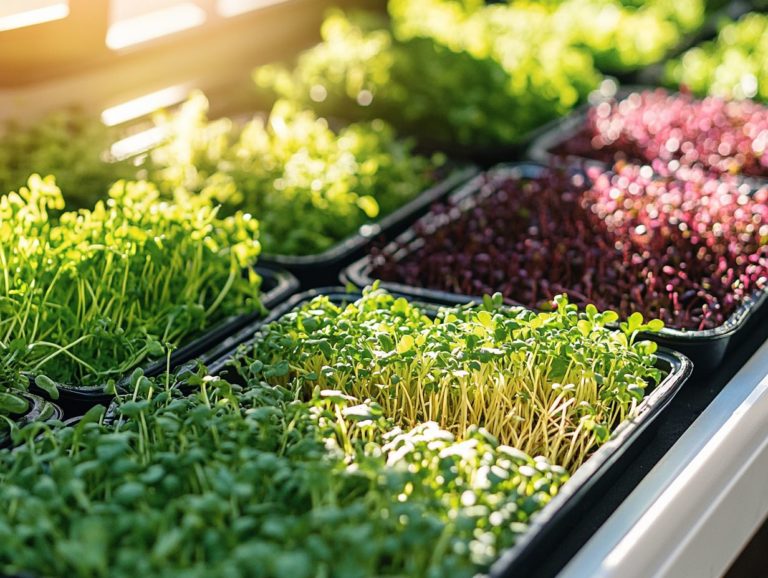Best Practices for Growing Diverse Microgreen Varieties
Microgreens offer far more than mere decoration; they deliver a remarkable burst of flavor and nutrition that can transform any dish into a culinary masterpiece.
This article explores the many benefits of cultivating a variety of microgreens, highlighting their impressive health advantages and unique culinary uses.
You will find valuable insights on selecting the ideal types to suit your needs, best practices for planting and harvesting, and tips for overcoming common growing challenges.
Whether you’re a seasoned gardener or just starting your gardening journey, this guide will help you grow your own delicious microgreens today!
Contents
- Key Takeaways:
- Benefits of Growing Diverse Microgreen Varieties
- Choosing the Right Microgreen Varieties
- Best Practices for Growing Diverse Microgreen Varieties
- Troubleshooting Common Issues
- Frequently Asked Questions
- What are the best practices for growing microgreen varieties?
- How do I choose the right microgreen varieties to grow?
- Do I need special equipment to grow microgreen varieties?
- How often should I water my microgreen varieties?
- Can I grow microgreen varieties indoors?
- How long does it take to grow microgreen varieties?
Key Takeaways:
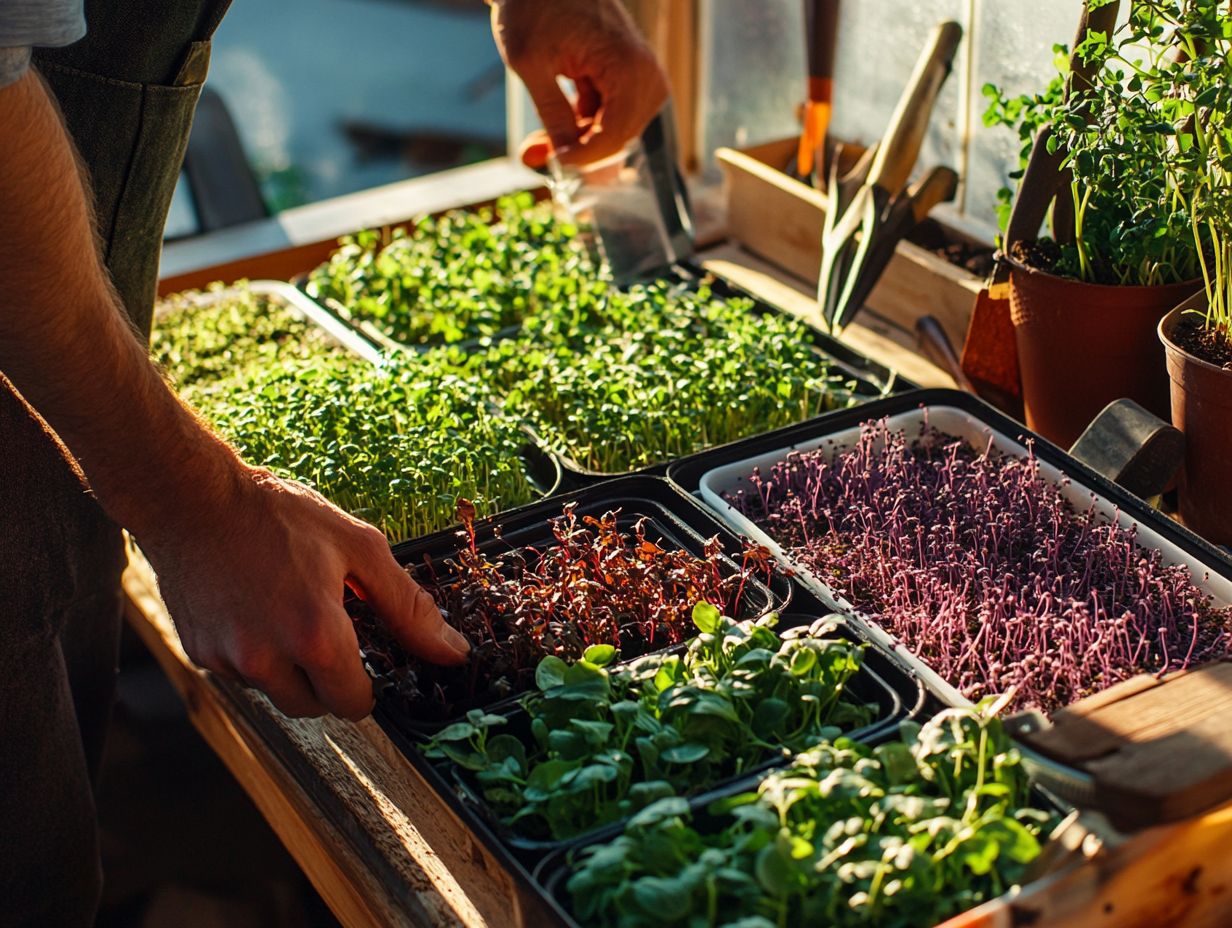
- Diversifying microgreen varieties provides a wealth of nutritional and flavor benefits.
- When choosing microgreens, consider factors such as growth time, flavor, and compatibility with your growing environment.
- To successfully grow diverse microgreens, proper preparation, optimal growing conditions, and careful harvesting are crucial.
What are Microgreens?
Microgreens are young, edible plants harvested at the seedling stage, usually within 7 to 21 days after germination. These tiny powerhouses are packed with flavor, color, and nutrients, making them a delightful addition to a wide range of dishes.
Varieties like basil, kale, and arugula can be easily grown in containers or on your windowsill, allowing you to enjoy the benefits of fresh, homegrown produce right from your kitchen.
Embracing microgreens is not just about cooking; it s a journey that bridges casual culinary endeavors with serious gastronomic exploration.
Beyond their appealing taste and vibrant colors, microgreens are nutrient-dense, meaning they contain a lot of vitamins and minerals in a small amount. They are incredibly versatile in the kitchen, enhancing salads, sandwiches, and smoothies making them an ideal choice for anyone embracing a vegan lifestyle.
To cultivate these petite powerhouses, you don t need an expansive garden or advanced skills; just grab a shallow container, quality soil, and a splash of water. Regular harvesting encourages new growth, ensuring you have a continuous supply of greens that can elevate your meals and health routines.
Benefits of Growing Diverse Microgreen Varieties
Growing a variety of microgreens improves nutrition and cooking. These petite powerhouses are packed with vitamins and minerals that support mental health and overall well-being.
Whether you incorporate vibrant salad greens or aromatic herbs like cilantro and oregano, each microgreen adds its own distinct flavor and nutritional profile to your plate. This not only inspires culinary creativity but also makes grocery shopping an exciting adventure.
Nutritional Benefits
The nutritional benefits of microgreens are impressive; they can contain up to 40 times more nutrients than their mature counterparts. These tiny powerhouses are rich in vitamins A, C, E, and K, making them an excellent resource for anyone following a vegan diet or simply looking to enhance their meals.
Incorporating microgreens into your meals increases the nutrient density of your diet, contributing to better physical health and improved mental well-being.
Microgreens are also abundant in essential minerals like iron, calcium, and magnesium, which are crucial for maintaining bone and muscle health. Research shows that regularly consuming these tiny greens can elevate your antioxidant levels, helping to combat oxidative stress and inflammation, often linked to chronic diseases.
For those on the journey toward better health, these nutrient-dense options not only support physical wellness but can also act as natural remedies, aiding digestion and boosting your immune system.
By integrating a variety of microgreens into your meals, you ensure a diverse intake of essential nutrients, aligning perfectly with dietary recommendations aimed at enhancing your overall well-being.
Start your microgreen garden now and experience the flavors!
Flavor and Culinary Benefits
Microgreens bring a delightful burst of flavor and a splash of vibrant color to your dishes, transforming simple meals into gourmet experiences.
With a variety of flavor profiles at your fingertips, from the peppery zing of arugula to the aromatic notes of basil and cilantro, you have endless culinary adventures awaiting you. Whether you’re a home cook or a professional chef, get ready to transform your cooking!
Incorporating these delicate greens into your meals not only improves the aesthetics but also enhances the flavor. This turns cooking into an exciting and flavorful journey.
For instance, a sprinkle of radish microgreens can elevate your creamy avocado toast, adding a delightful crunch and a spicy kick. A handful of pea shoots can beautifully complement a light summer salad, creating a fresh and vibrant dish that sings with flavor.
Even in classic recipes, like soups or stews, stirring in some fresh dill or sunflower greens can make each bite a refreshing burst of goodness.
These versatile little greens invite you to experiment and unleash your creativity in the kitchen. Discover new taste pairings and refine your cooking techniques don t miss out on the incredible flavors waiting for you!
Choosing the Right Microgreen Varieties
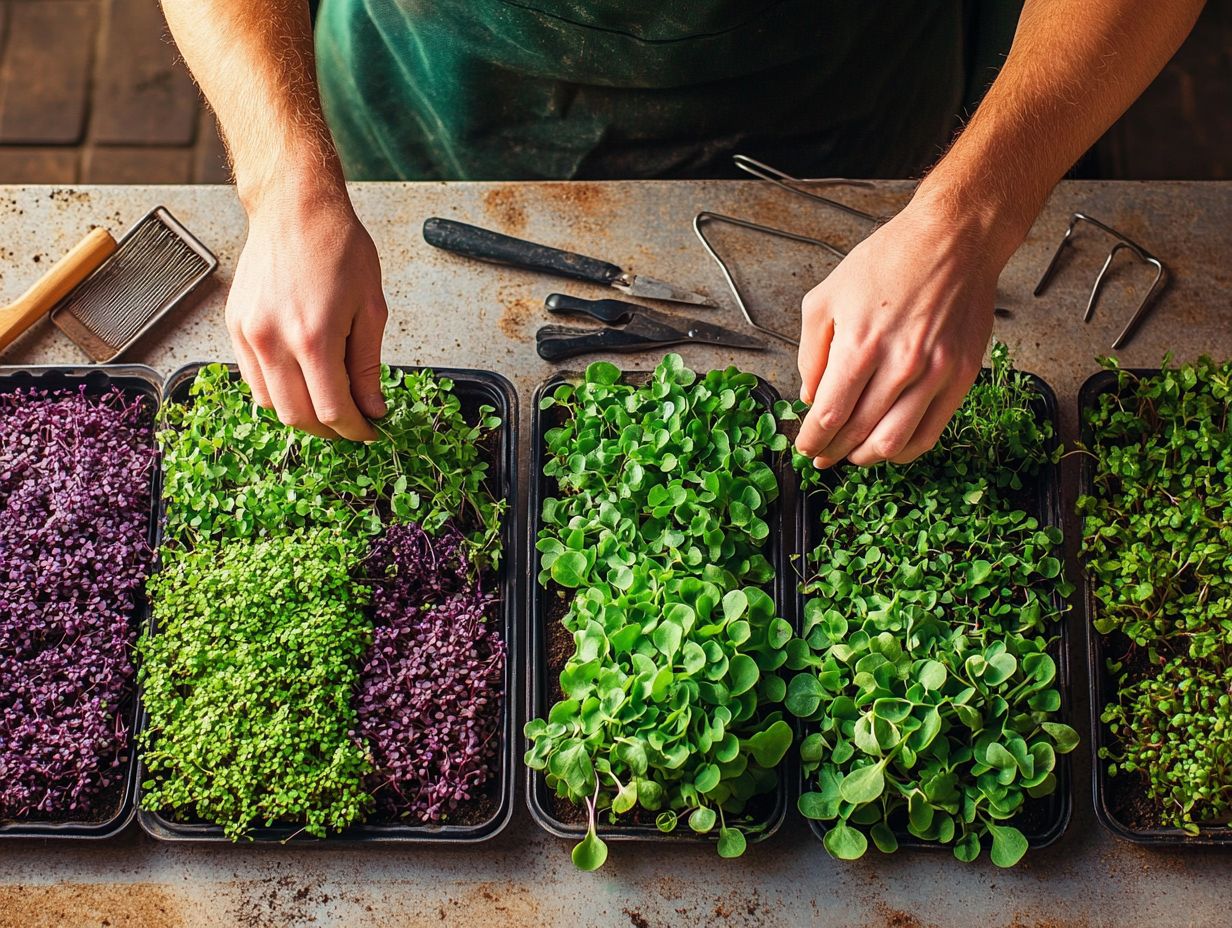
Choosing the right microgreen varieties is essential for enhancing both the benefits and taste of your homegrown produce. Consider your flavor preferences, culinary applications, and the specific growing conditions in your space. These factors will guide you in selecting the ideal microgreens for your gardening journey.
By exploring the unique characteristics of each variety such as the spicy kick of radish greens or the delicate flavor of kale you can cultivate a garden that’s as diverse as it is flavorful.
Factors to Consider
When selecting microgreen varieties, consider several key factors for successful growth and maximum flavor:
- Sunlight exposure
- Soil mixture
- Flavor profile
Some varieties thrive in bright sunlight, while others flourish in partial shade. Matching the plants to their intended environment and available resources is essential.
The soil mixture is crucial; a well-aerated blend rich in organic matter can significantly enhance germination rates (the speed at which seeds sprout) and provide necessary nutrients. Varieties like radish and arugula prefer a slightly moister environment, while basil and chard thrive in drier conditions.
Understanding these preferences is vital radish microgreens can handle quick watering intervals, but basil is sensitive to overwatering, which can lead to root rot.
Light intensity also greatly influences coloration and taste. Sun-loving varieties, such as cilantro, develop a more robust flavor when placed in optimal sunlight. By considering these various factors, you can create the perfect growing conditions tailored to each microgreen variety.
Best Practices for Growing Diverse Microgreen Varieties
Implementing best practices for cultivating a variety of microgreens is essential for achieving vibrant plants and optimal flavor. From choosing the right growing containers to preparing an ideal soil mixture, every step is crucial in successful microgreen gardening.
By honing your plant care techniques such as precise watering, humidity management, and appropriate light exposure you can nurture microgreens that are not just nutritious but also brimming with incredible flavor.
Start your microgreen garden today and enjoy fresh flavors!
Preparation and Planting Techniques
Preparation and planting techniques are essential for achieving successful microgreen growth. Start with careful selection and soaking of your microgreen seeds. Soaking the seeds before planting significantly enhances the germination process, ensuring quicker and more uniform growth. Using a well-balanced potting mix a special type of soil for planting provides your microgreens with the best possible start, offering vital nutrients and moisture for optimal development.
To kick things off, choose organic seeds specifically tailored for microgreens. A quick soak for four to six hours helps soften the seed coat and promotes hydration, activating germination. Once soaked, drain the seeds and let them rest for a couple of hours.
Next, prepare a lightweight, free-draining potting mix. This is crucial for preventing root rot while maintaining the right moisture levels.
After filling your trays with this mix, scatter the seeds evenly on top and give them a light mist to settle them in nicely. Covering the seeds with a thin layer of soil boosts their chances for successful germination. For best results, apply watering techniques for thriving microgreens to ensure consistent moisture and temperature, creating an ideal environment for growth and setting the stage for a flourishing microgreen garden.
Optimal Growing Conditions
Achieving optimal growing conditions is essential for cultivating healthy microgreens, which thrive in specific environmental settings. Maintain moist soil, ensure adequate sunlight exposure, and provide the right temperature. These are the cornerstones of successful microgreen gardening.
Container gardening allows you to place your plants just right, making it easier to control these conditions and create an environment tailored to the unique needs of different microgreen varieties. To optimize your efforts, consider learning how to extend the growing season for microgreens.
For instance, varieties like basil and arugula do best with about 12-16 hours of light daily, ideally from a south-facing window or supplemented with grow lights. Keep the soil consistently damp but not soggy, as too much water can invite mold or rot. Temperature is crucial; most microgreens thrive between 60 F and 70 F, promoting germination and growth while minimizing the risk of heat stress. To learn more about optimal practices, check out these techniques for growing microgreens year-round.
By carefully managing these elements that make your garden thrive, you can successfully grow a vibrant assortment of microgreens right in your own home. For a detailed approach, refer to this step-by-step guide to sowing microgreens.
Harvesting and Storing Tips
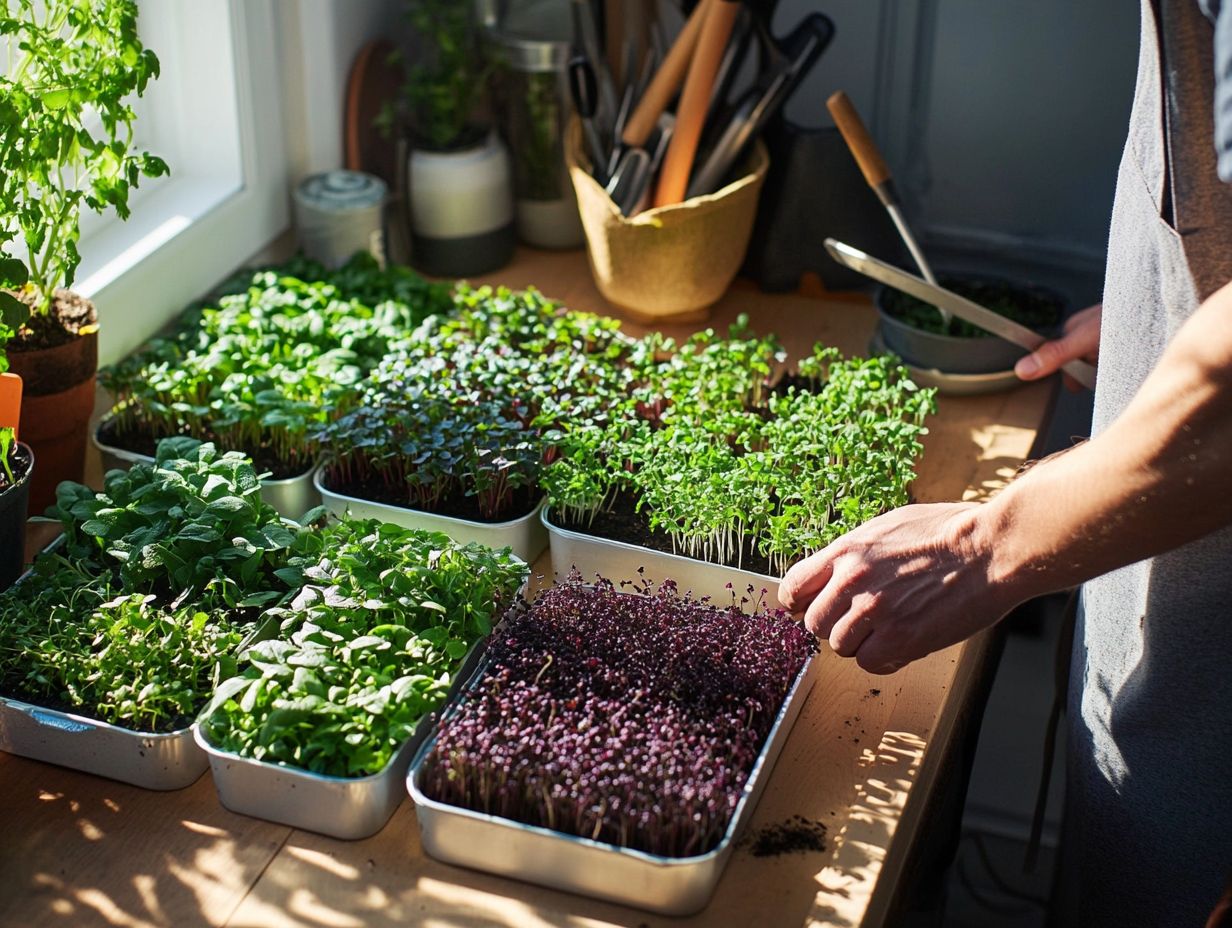
Proper harvesting and storage techniques for microgreens are essential to preserving their freshness and nutritional value. When you’re ready to harvest, use a sharp pair of scissors. Cut the greens just above the soil line to minimize damage and encourage further growth.
Store your microgreens in a cool, dry place or the refrigerator. Consider using a kitchen scale to measure portions accurately for your culinary masterpieces.
To extend their shelf life, place the cut microgreens in a breathable container, like a box lined with a damp paper towel. This helps prevent excess moisture from accumulating. Keep your microgreens between 34 F and 40 F for the best freshness.
Using airtight containers or jars is another excellent strategy to protect their delicate leaves from wilting and oxidation. Regularly check for signs of spoilage and enjoy incorporating these vibrant greens into your dishes while they re at their peak freshness.
Troubleshooting Common Issues
Troubleshooting common issues in microgreen cultivation is crucial for nurturing a thriving garden and preventing unforeseen setbacks. Challenges like pests, diseases, or unfavorable environmental conditions can stifle growth and compromise the quality of your microgreens.
By identifying potential issues early and implementing robust pest management strategies, you position yourself to cultivate a healthy microgreen garden that consistently flourishes.
So why wait? Start growing your microgreens today and enjoy the fresh, nutritious greens right from your home!
Pest and Disease Management
Effective pest and disease management is essential for successfully growing microgreens. These delicate plants can face various challenges. By utilizing natural pest control methods like neem oil or insecticidal soap, you can tackle pest problems without harming the environment or compromising your health.
Sourcing quality seeds and growing media from a reputable gardening store will significantly lower the risk of diseases in your microgreen garden.
You can enhance your efforts by integrating companion planting, which involves growing certain plants together to help each other. This approach creates a natural barrier against pests while enriching your soil.
Regularly monitor for signs of infestations, and maintain proper watering and air flow to keep your fragile crops thriving. Investing in the right gardening tools such as fine mesh nets or organic pest deterrents can further strengthen your pest management strategy.
By emphasizing sustainability in your gardening practices, you ensure healthier yields and contribute positively to the environment, promoting a more eco-conscious approach to growing microgreens. Start applying these tips today to protect your microgreens!
Environmental Factors
Environmental factors are pivotal in the growth and success of microgreens, impacting everything from germination to flavor development. Keep a close eye on elements like sunlight exposure, soil moisture, and temperature to create optimal conditions for your plants.
By understanding and adjusting these factors, you can cultivate a flourishing microgreen garden that yields flavorful and nutritious greens. Light is essential; microgreens thrive best under bright, indirect sunlight or specialized grow lights that replicate this spectrum.
Maintaining consistent moisture levels is equally vital; soil that’s too dry can stunt growth, while overly wet conditions might invite mold.
Temperature control shouldn t be overlooked, either most microgreens prefer a stable range between 60 F to 70 F (15 C to 21 C).
By fine-tuning these environmental aspects, you can develop a more robust microgreen system, leading to better yields and enhanced flavors, ultimately elevating your entire gardening experience.
Frequently Asked Questions
What are the best practices for growing microgreen varieties?
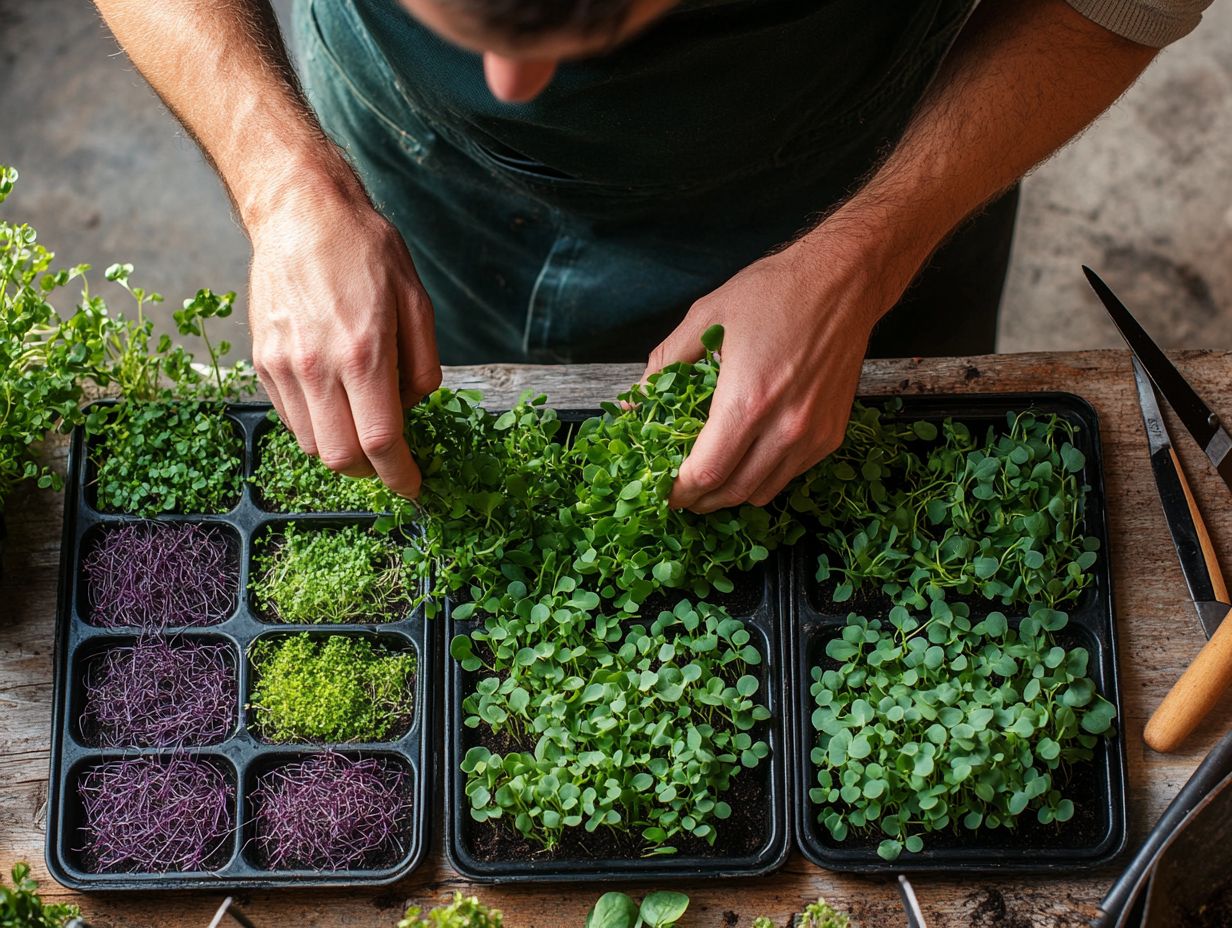
- Select high-quality seeds.
- Use a well-draining growing medium.
- Provide adequate lighting and air circulation.
- Maintain proper watering and temperature levels.
How do I choose the right microgreen varieties to grow?
When choosing microgreen varieties, consider factors such as flavor, color, and nutritional value. Research different types of microgreens and their growth requirements to determine which ones will thrive in your specific growing conditions.
Do I need special equipment to grow microgreen varieties?
You do not necessarily need special equipment to grow microgreen varieties. However, having a grow light, trays or containers, and a fine-mesh sieve for watering and draining can greatly improve your success.
How often should I water my microgreen varieties?
The frequency of watering will depend on factors such as the type of microgreen, the growing medium, and the temperature and humidity levels. Generally, microgreens should be watered once a day or every other day, with a light misting to keep the soil moist but not soggy.
Can I grow microgreen varieties indoors?
Yes, microgreens can be easily grown indoors as long as they have access to adequate lighting and proper air circulation. You can also control the growing conditions more easily indoors, making it an ideal environment for growing microgreens.
How long does it take to grow microgreen varieties?
The time it takes to grow microgreens will vary depending on the type and the growing conditions. On average, microgreens will be ready to harvest in 1-3 weeks after planting. Regularly check the growth progress to determine when they are ready to be harvested.

